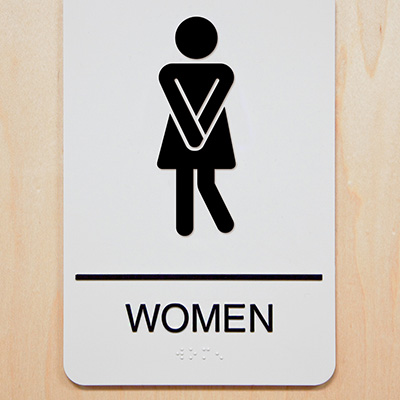Vitality eNews Sign Up
Receive the Summa Health eNewsletter for the latest health tips, advice and updates.
Take Control and Get Relief from Common Bladder Control Issues
Posted November 28, 2022 by Jenifer Byrnes, D.O.

If you’re like most females, problems with frequent urination, bathroom emergencies and leaking urine may not be something you want to talk about. It can be embarrassing and uncomfortable to discuss bladder control issues with your healthcare provider.
But, you don’t need to keep them hidden. Bladder control issues are a very common — and treatable — problem.
According to the U.S. Office on Women’s Health, about 40 percent of females aged 65 and older experience bladder control issues. It affects twice as many females as males, most likely due to reproductive health events unique to females, such as pregnancy, childbirth and menopause, that can affect pelvic muscle strength.
What’s more, bladder control issues are not just a medical issue, they can have a major impact on your quality of life. They can be unpredictable and cause embarrassment, anxiety, fear and anger. If you’re afraid you won’t be able to control your bladder, you might avoid the things that bring you happiness, such as intimacy, social activities, travel and hobbies that take you away from your home.
Learn more about common bladder control issues in females and what treatment options are available. While talking to your healthcare provider can be embarrassing at first, finding the urge to be open and honest with your provider will help you get the relief you need to get your life back.
Common Bladder Control Issues
Stress incontinence
Stress incontinence occurs when sudden abdominal pressure, or stress, on your bladder when you cough, sneeze, laugh or exercise causes urine leakage. Weak pelvic floor muscles allow urine to escape, whether it’s a few drops or a tablespoon or more. Stress incontinence is one of the most common types of bladder control problems and one that affects younger females, too.
Urge incontinence
Urge incontinence, otherwise known as overactive bladder, causes a sudden, hard-to-control urge to urinate that cannot be ignored. At times, you may even leak urine before you can get to the bathroom. With this condition, the nerve signals between the brain and the bladder are not functioning correctly. The bladder may sense it’s full prematurely and communicates to the brain that it’s time to go.
Overflow incontinence
Overflow incontinence occurs when the bladder cannot hold all of the urine produced by the body, causing urine to leak out.
Pelvic organ prolapse
Pelvic organ prolapse (POP) is the descending of the pelvic organs, including the bladder, vagina and uterus, as a result of weak pelvic floor muscles. Typically, pregnancy, aging and menopause are to blame. Pelvic organ prolapse can cause urinary incontinence, frequent urination and a feeling like the bladder is not completely emptied.
Treatment for bladder control issues
Many females believe bladder control problems are a part of aging and there’s nothing they can do. But, that’s not the case. Most bladder control issues are treatable and manageable.
Typically, the first line of treatment is behavioral changes and at-home exercises. Losing weight to alleviate excess pressure on the bladder and limiting fluid intake before bedtime or activities that last several hours can help. In addition, try these tips:
- Dietary changes: Limit consumption of bladder irritants, such as coffee, caffeine, carbonated drinks and alcohol.
- Bladder training: Try training your bladder by holding your urine for longer and longer periods of time in between bathroom breaks. Also, don’t take “just-in-case” pee breaks.
- Timed voiding: Set a schedule during the day for bathroom breaks about every 2 to 4 hours, instead of going when you feel the urge, to help prevent emergencies and regain control.
- Double voiding: After going to the bathroom, wait a few seconds and then try again to ensure you fully empty your bladder.
- Bladder exercises: Strengthen your core muscles and do regular Kegel exercises to help strengthen pelvic floor muscles and improve bladder control.
If behavioral changes don’t work, additional treatments are available. Your healthcare provider may prescribe medication to help control an overactive bladder by relaxing the muscles.
Other treatment options can include:
- Biofeedback: Biofeedback can help you learn how to control your bladder muscles.
- Nerve stimulation: Mild electrical pulses are sent to stimulate nerves in the bladder. The pulses can increase blood flow and strengthen the muscles that control the bladder.
- Botox injection: A Botox injection can be used to relax your bladder muscles and increase the amount of urine your bladder can hold.
- Vaginal pessary device: A small silicone device, shaped like a ring or small donut, is placed in the vagina to support the pelvic floor muscles and help reduce stress incontinence.
For severe cases, surgery is an option for more permanent solutions. For example, surgeons can implant a device that transmits electrical pulses to stop your bladder from contracting. They also can enlarge your bladder or place a catheter to help remove urine. Sling procedures to hold the bladder in place are also common to treat stress incontinence.
You don’t have to live with these common bladder issues. Talk to your healthcare provider about symptoms and get the treatment you need so you can get back to life — without the worry of leakage or bathroom emergencies.
